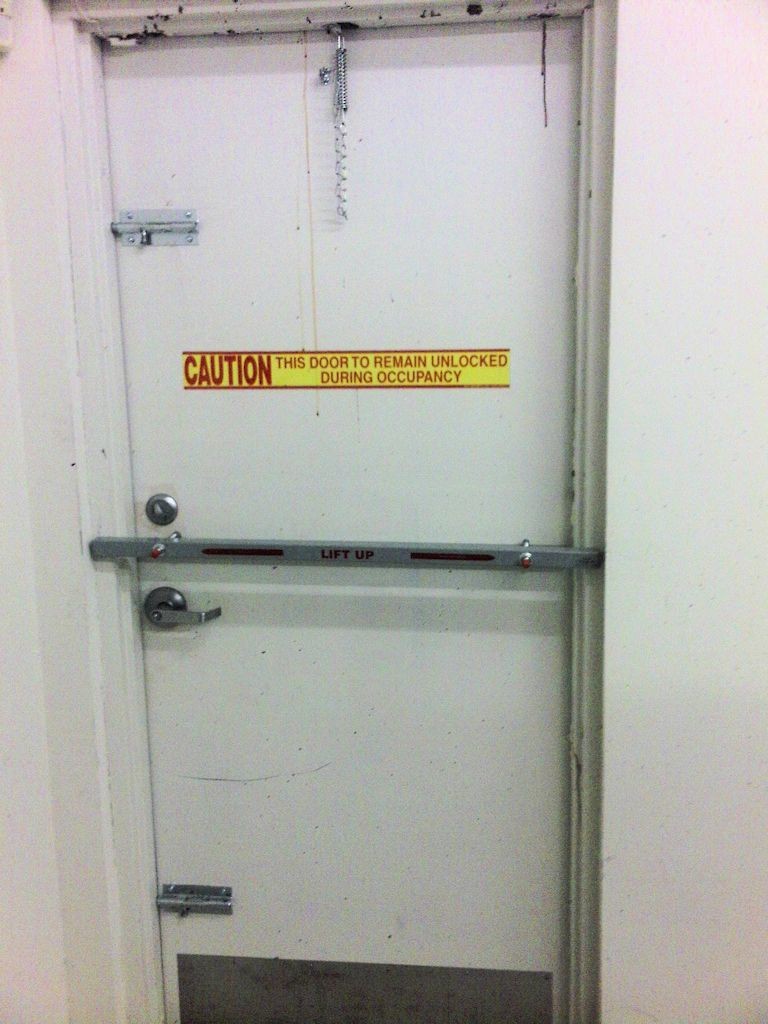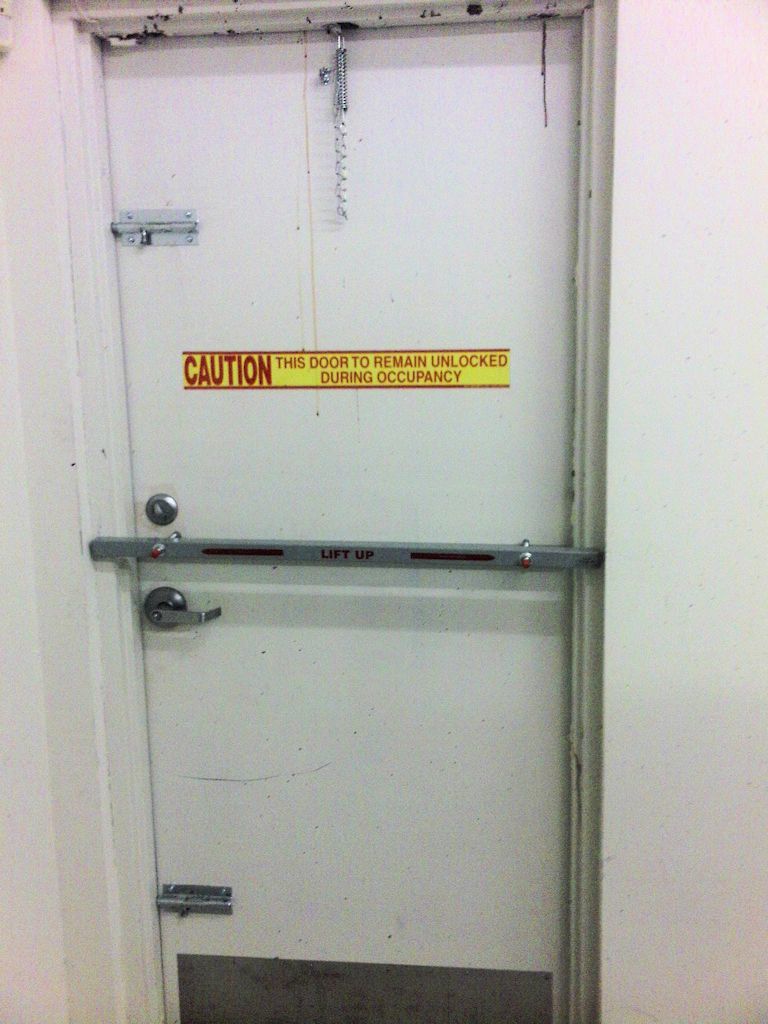 Ian Greene of Locknet set me this Wordless Wednesday photo of a door that Locknet was asked to retrofit with two more security bars!
Ian Greene of Locknet set me this Wordless Wednesday photo of a door that Locknet was asked to retrofit with two more security bars!
If this retail store is located in Kentucky (where Ian is located), the applicable code looks like it would be the 2012 edition of NFPA 1 – Fire Code. According to NFPA 1-2012:
14.5.2.10.1 The releasing mechanism for any latch shall be located as follows:
(1) Not less than 34 in. (865 mm) above the finished floor for other than existing installations
(2) Not more than 48 in. (1220 mm) above the finished floor [101:7.2.1.5.10.1]
14.5.2.10.2 The releasing mechanism shall open the door leaf with not more than one releasing operation, unless otherwise specified in 14.5.2.10.3 and 14.5.2.10.4 or 14.5.2.10.6. [101:7.2.1.5.10.2]
The NFPA 1-2012 Handbook further explains the safety vs. security balance:
An increase in thefts, muggings, and similar crimes has led to the practice of providing extra security on door assemblies within the means of egress. Such a practice, particularly where door assemblies to exit stairs and exit discharges are involved, is an open invitation to tragedy in the event of fire or other emergency. The provisions of 14.5.2 are aimed at preventing locked door assemblies in means of egress or any other unnecessary interference with the orderly movement of people through door openings in the event of fire. The Code has attempted to accomplish this objective while maintaining features that are essential to security within the building.
What do you think? Does this door meet the intent of NFPA 1 if the security devices are only engaged when the building is not occupied?
You need to login or register to bookmark/favorite this content.






Depending on when the door hardware was placed in service it might be permitted to have two additional releasing operations per NFPA 1, 2012 edition, 14.5.2.10.4 and be located up to 60 inches above the floor per NFPA 1, 2012 edition, 14.5.2.10.5.
These same provisions were also in the 2009 edition, I believe
This is someone who has not thought about what happens when the incident occurs inside the facility.
Nope not good
Plus more than likely NFPA 1 has something about slide/ surface bolts
I would use a Securitech three point auto relock for this application.
I also try to be retro active when coming across these situations we face. Inform end user to bring all openings up to code.
I would say that this door does not comply with a reasonable interpretation of code for several reasons. “The provisions of 14.5.2 are aimed at preventing locked door assemblies in means of egress or any other unnecessary interference with the orderly movement of people through door openings in the event of fire.” This quote says it all. We have all seen it before. Bars are in place and manager says I forgot or I didn’t know. Happens all the time and they get away with it. If they are going to allow these devices, give the AHJ some power to enforce it. If they find a violation, close the establishment at that moment and let them think about it overnight. For a second violation, 3 days closed.
Whenever I see a sign like this one, I wonder how the place can be considered unoccupied since whoever locks it is still in the building?
Hi Lou –
NFPA 101 defines occupied as:
7.2.1.1.3 Occupied Building.
7.2.1.1.3.1 For the purposes of Section 7.2, a building shall be considered to be occupied at any time it meets any of the following criteria:
(1) It is open for general occupancy.
(2) It is open to the public.
(3) It is occupied by more than 10 persons.
So the building could still be not occupied even it if was occupied by the photographer.
– Lori
Horrid! What inspector would let this fly? When Grandma can’t claw her way through this door when there’s a fire, the lawyers will (rightfully) come after whoever did it, and any AHJ who granted the exception.
No. The needs for security (ostensibly “after hours”) does not trump the requirement for safe egress. This apparatus could also be used by someone with malicious intent to stop emergency responders from accessing the entry if there were a key in the outside trim or as a an effective barricade against entry in the event of some sort of hostage situation.
The safety needs of both the store employees and customers must have priority over whatever benefit might be gained from use of this multitude of simple security devices. If there is indeed need for multi-point engagement for the door with the frame there are ample locking devices available that meet that need while providing safe, simultaneous latch retraction.
There is a lot going on with this particular door and if locked, there are five releasing operations required. Occupied or not, I don’t like what I see. And you say the owner wants more security bars? Holy deathtrap, Batman!